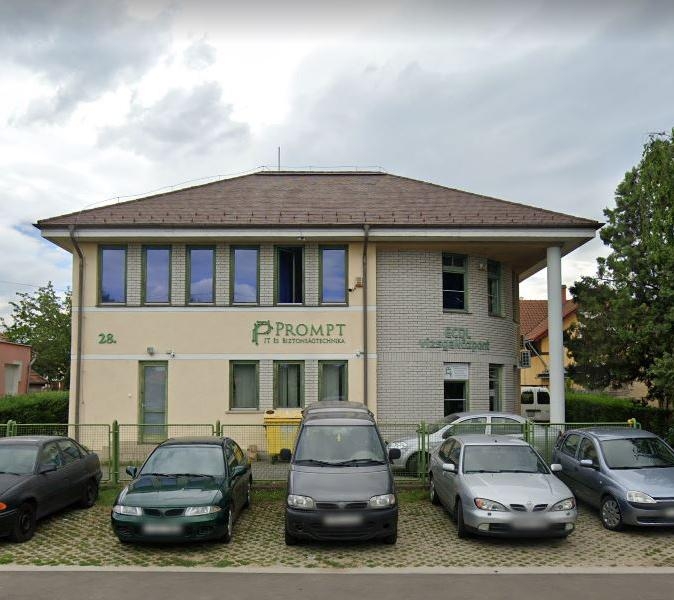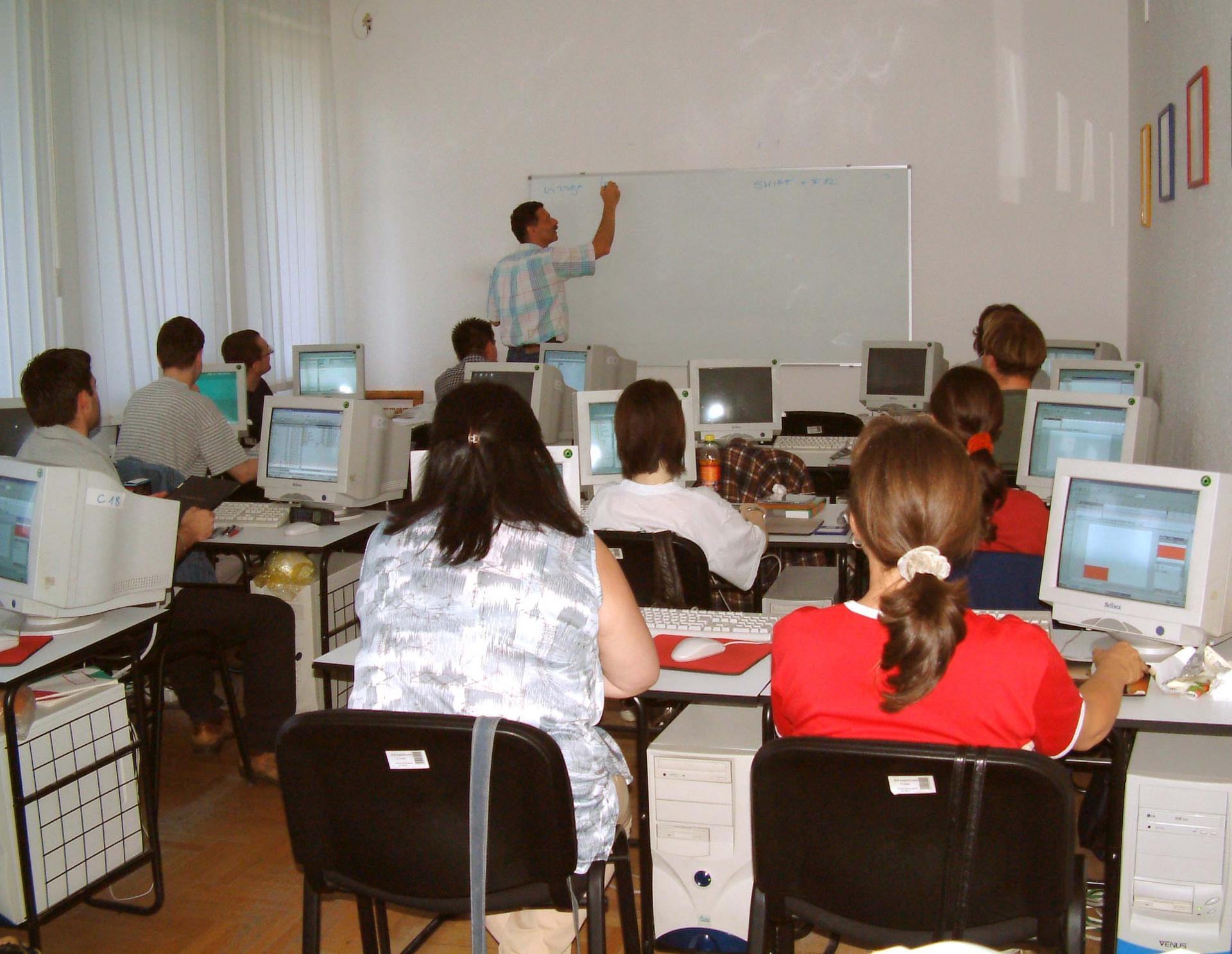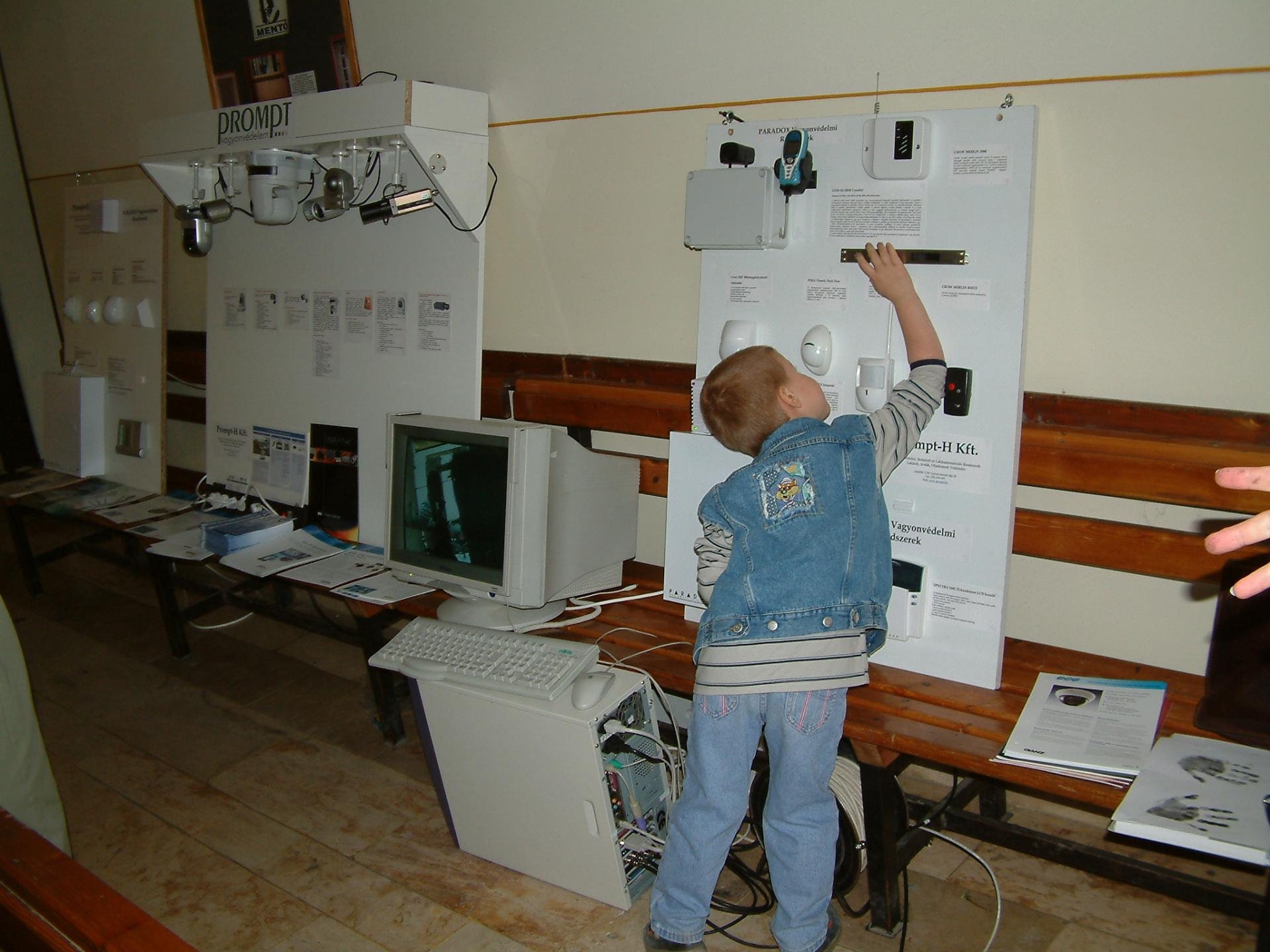Our History

Business information
Name: Prompt Computer Science Ltd.
Location: Gödöllő, 28 Testvérvárosok Street
Legal status: limited liability company
Managing director: dr. József Lengyel mechanical engineer, OS system programmer, mathematician engineer
Prompt Computer Technology was established in 1989 by university lecturers with decades of teaching and research experience, for the development and distribution of software and hardware products and computer science education.
We started our activity in a small apartment in Gödöllő, then in 1993 we moved to a 200 square meter rental property, and since January 1998 we have been working in the headquarters built as our own investment.

The leadership of Prompt has always believed that standing on several legs is a basic prerequisite for long-term viability of small Hungarian companies. Education, development and trade are mutually reinforcing activities in information technology.
Prompt has all the material and human resources that allow it to provide a full range of computing services. This is due to its leading role in the market of IT service providers around Gödöllő.
Educational activity
Our activity was started in 1993 with a computer operator course. To do this, we designed classrooms in a municipally owned rental property. In 1994, our range was expanded with software operator, in 1996 with business IT specialist, and in 1997 with educational IT specialist courses. In 1995, our training center became a member of the Association of Adult Education Enterprises. Mária Hartyányi (director of the training center) became a member of the FVSZ qualification committee and the board of the Computer Science Department.
We set up a computer training center on the upper level of our new, two-storey office building, completed in 1998, with three networked machine rooms equipped with Pentium II machines and Internet access.

Our training center became an ECDL exam center that year, and we also started new courses: software operator + English (1998), computer operator + English (2000), multimedia developer (2000; two-year, school-based OKJ vocational training), computer programmer (2002).
For years, education had been provided in full-time, 8-10 hours a day in our classrooms: vocational trainings, primary, secondary and tertiary full-time and evening OKJ trainings of computer science. Since many of the staff of the Mayor's Office in Gödöllő and a lot of students from primary and secondary schools in Gödöllő and the surrounding area, took part in them, so many people in the area have some fond memories of the Prompt.
In addition to the courses giving a state-recognized certificate, we also organized special courses for company orders, according to individual needs. The largest customer of our intensive full-time trainings was the Pest County Labor Center.
The clients of our shorter, specialized evening trainings (system administrator, web technician) were companies and enterprises from Gödöllő and Pest County (eg Tiszántúl Gas Provider Corporation. from Gödöllő and Hungaropharma Pharmaceutical Trading Corportaion, GalUg. Budapest Lindner Kft.).

E-learning developments
We started our distance-learning developments in 1998. We created an interactive multimedia instructional CD for the curriculum of several trainings, and used the electronic curriculum in our open-access distance-learning programs.
As there was a growing demand from companies for special, specialized in-service training that can be done next to full-time jobs and provides serious, immediately usable knowledge, we considered it expedient to supplement evening trainings with distance learning elements and to start certain courses in the form of distance learning.
Our online distance learning program of web techinician started in 2000 as an open vocational training, which we developed within the frames of the tender announced by NYITSZAK.
We started developing our first non-contact online education program in 2001. We created an electronic curriculum and a framework for the six modules of the web programming training.
The Internet / ECDL training program developed by the Székesfehérvár Regional Workforce Development and Training Center was implemented with 100 students.
Quality Management System
In 2000, we started to build a quality management system according to the ISO 9001: 2000 standard.
In the summer of 2000, the Ministry of Education issued a call for proposals for non-school educational institutions with the intention of integrating elements of the Comenius quality assurance program already implemented in the school system into their previously started quality improvements.
We won support in the tender, and thus continuing the development started according to the ISO 9001: 2000 standard, we incorporated the elements of the Comenius quality development program applied in Hungarian public education into the system. The certification was completed in December 2001 without error.
Our education activity nowadays
The company's education department, the Prompt Training Center, became independent in 2008 under the name of iTStudy Hungary. Putting the education and training profile in the foreground, as a licensed institution, it will continue the work it has started within the framework of adult education, supplemented by significant educational development and research activities.
Software and hardware development
The most important development direction represented by the company is image processing, development of multimedia systems and their application in security technology.
Our founding members started developing multimedia applications in 1985.
Computer Controlled Video System (CCVS)
In 1992, we launched a computer system called CCVS (Computer Controlled Video System), which can be used in many areas of the national economy. CCVS was presented at CeBIT in 1992 and then in 1993, which is still one of the most prestigious international infocommunication exhibitions to this day.
CCVS was a hardware-software tool that used analog and digital image processing technology together, allowing video to be programmed as a computer peripheral, and thus the film material to be treated as a computer database. (The name of the database created by image-voice-text integration in today's computer terminology is hypertext.)
Of course, analog storage of images could not be a definitive solution, but at the time of the first developments, there was no hardware or software available that could digitally store the huge image material created during dynamic recordings. The emerge and spread of igh-capacity storages (CD ROM, CD, optical disc) and the development of digital technology have created the technical background for the further development of the system.
The product has proven to be useful in education, advertising technology, medical practice, security technology and hypertext software-hardware technology.
Educational multimedia
The very first version of the CCVS was made in 1985 at the Gödöllő University of Agricultural Sciences for educational purposes. The system was then used to implement a simple knowledge testing program based on an agricultural educational film. Today, the first development has historical significance only.
Hardware configuration used: Commodore 64 microcomputer, UMATIC professional VCR. Software used: a unique application program developed in BASIC using control routines written in Commodore Assembly.
Publication:
Telemedia International Education Conference Budapest, 1991
The system was described by MTV in "Computer on Show" series.
Advertising Technology—"Sightseeing in Vienna"
As a tourism application, CCVS was used to implement a multimedia database made from an educational video about Vienna.
System components: IBM PC XT, CGA display, ITT VCR, CCVS0 control card. Software used: A custom application program developed in a Pascal environment based on assembly video control routines.
Publication:
"Sightseeing in Vienna" video computer database.
“Travel 90” International Tourism Exhibition, Budapest, 1990.
Our system was also presented by an Austrian company at the IFABO exhibition in Vienna.
Cipres – Customer Information and Presentation System
For the western distribution of CCVS, the Dutch-Hungarian joint venture called ImViSol was established, which marketed the implementation of the system under the name Cipres. The product was unveiled at CeBIT in the spring of 1993 as a general presentation tool for exhibitions.
System components: IBM PC AT configuration, Siemens video, Kodak, image disc player, CCVS control card and software (DOS environment), five-button search keyboard.
Large-sized billboard
In 1994, the CCVS video control system was connected to a billboard. The advertising material on the board was manageable in an interactive way. The billboard control system was sold by the customer in 1994 on the Russian market. The system required both software (video control, image display on the board) and hardware development (connection of the billboard, video and computer).
System components: IBM PC AT configuration, CCVS control card and software (DOS environment), PROMPT mixer card, billboard.
The prototype operated in Blaha Lujza Square in Budapest.
Film database of museum objects
It is not advisable to move millennial museum objects too often. The capacity of the exhibition halls does not allow the public to see all important historical objects live. At the same time, there is a very common need to present certain museum objects in professional or educational lectures.
At the request of the Hungarian National Museum, we developed a computer video database management hardware-software system that meets the above-described needs.
The system was a completely new, unique development in terms of both software and hardware. On the software side, the novelty of the solution was that the film database had to be adapted to a computer database created under the already developed Data Ease software package. A by-product of the development was the VideoBase software-independent image integrator, with which we could fit images to any ready-made database.
Publication:
“Computer in Museology”, conference, Budapest, 1991.
article in Computer Panorama, July 1993
System components: IBM PC AT, home TV as video display, ITT VCR, CCVS1 control card. Software used: Resident video control and retrieval program system developed in C programming environment.
Video Documentation Interface: VIDOK 1.0
Endoscopic examinations were performed at the BM Central Hospital in Budapest in the 1990s, and video endoscopy was introduced two years ago at that time. The hospital's specialists were looking for a computer tool that could be used to solve the intelligent archiving of X-rays.
In 1992, we made a custom version of CCVS2 for computer archiving and retrieval of X-rays.
In the system, the computer was connected to a Siemens X-ray machine. In the surgical department, the new method was first introduced in intraoperative procedures - cholangiography, angiography, abdominal examinations (laparoscopy) and arthroscopy.
VIDOK 2.0
Of course, analog storage of images could not be a definitive solution, but at the time of the first developments, there was no hardware or software available that could be used to digitally store (not to mention cost) the huge amount of image material created during dynamic recording.
Publication:
Medical Conference, Budapest, 1992.
Medical Multimedia, Computer Panorama, March 1992
“Multimedia in Education” exhibition at the Gödöllő University of Agricultural Sciences, February 8, 1995
System components: IBM PC AT 486, GB HDD, 1.2 MB FDD, COLOR multimedia monitor, PANSONIC AG-5700 video. Software used: Windows 3.1 graphical interface, WatCom development environment
Floppy Book Interactive (FBI)
In 1996, we developed the FBI (Floppy Book Interactive) hypertext editor software package. The aim of the development was to create a general-purpose multimedia software environment in which an interactive computer-based educational or demonstration material combining images, text, sound and film can be compiled without programming knowledge.
PLASTIC
The National Police Headquarters (ORFK) has been looking for a multimedia tool for the Airport Passenger Safety Authority that is suitable for archiving and later using X-ray images of X-ray machines located at airport passenger hubs for the training of security staff.
During the implementation of the archiving system, we connected the computer to the HEIMAN package X-ray used in security technology with a special, self-developed control card. The card and control software were suitable for real-time digitization of the nascent image material.
The airport system operated from the 1990s to the early 2000s. It replaced paper-based administration by automatically saving an image of passed packets, and by using a chip card and card reader, it also registered who allowed the packet to proceed. The system also had an educational function: images saved in real situations were used to train airport security staff.
Publication:
“Multimedia in Education” exhibition at the Gödöllő University of Agricultural Sciences, February 8, 1995.
System components: network built from IBM PC AT, monitor + VGA controller, HEIMAN X-ray, special purpose control and digitizer card. Software used: Novell Network Op. system, WatCom C development environment, PLASTIC training system
Digital camera security and survelliance system
At the end of the 90's, we developed a digital security system based on digital image recording, called Digital Video Security System, suitable for surveillance of offices, warehouses and private areas.
The surveillance system software ran on an average PC configuration to which up to eight camcorders could be connected. In contrast to traditional video capture systems, our system only recorded when there was a change in the locations being monitored. In the image area captured by the cameras, we could select rectangular, so-called active zones (usually windows, doors, or surroundings of valuables). The software only responded to changes within the set zones, and changes to irrelevant parts of the image shown by the camera did not trigger recording. The number, size and position of the active zones could be adjusted arbitrarily.
In the database of the recorded footage, we could retrieve any event with a software specially developed for this purpose and replay it as a “cinema” with intermittent motion.
System components: IBM PC Pentium 133, Windows 95 operating system, DVSS software.
Publication:
Computer Panorama, 2001/3 Pp. 24–25.
Prompt is still one of the best-known security service providers in Gödöllő and in the region.

Digital alarm to protect summer and weekend houses
The digital alarm system provided a solution for the protection of properties where there was no telephone line, in some cases the power supply was interrupted, and in the vicinity of which no one could detect the normal audible alarm.
The device had a radio infrared sensor that was powered by a battery. If there was movement inside the property, the device sent an SMS to the owner via a radiotelephone or, if required, signaled the fact of the alarm with a continuous phone call until the called party answered the call. The only condition for safe operation was to have adequate field strength for the operation of the radiotelephone in the area.
As the device was only sensitive to indoor movement, a false alarm could not occur. The possible power failure was no problem either, as all devices were powered by a battery.
System components: infrared sensors, mobile phone, system box containing control software.
Publications: